Emerald toucanet
| Emerald toucanet | |
|---|---|
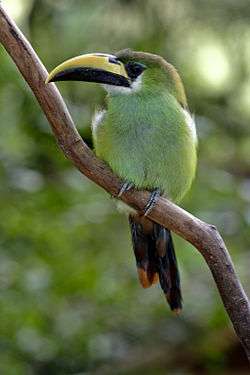 | |
| Emerald toucanet (nominate group) | |
| Scientific classification | |
| Kingdom: | Animalia |
| Phylum: | Chordata |
| Class: | Aves |
| Order: | Piciformes |
| Family: | Ramphastidae |
| Genus: | Aulacorhynchus |
| Species: | A. prasinus |
| Binomial name | |
| Aulacorhynchus prasinus (Gould, 1833) | |
| Subspecies | |
|
See text | |
The emerald toucanet (Aulacorhynchus prasinus) is a species of near-passerine bird in the Ramphastidae family occurring in mountainous regions of Mexico and Central America.[2] Several taxa formerly included within this species have now been re-classified into separate species of their own (see Taxonomy).
Taxonomy and systematics
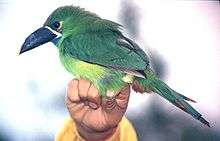
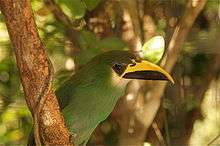
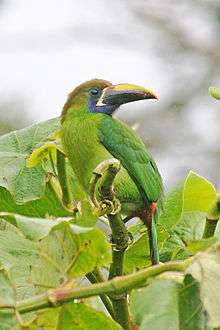
Subspecies
Four subspecies are recognized:[3]
- A. p. warneri - Winker, 2000: Found in south-eastern Mexico
- A. p. prasinus - (Gould, 1833): Found in eastern and south-eastern Mexico, Belize and northern Guatemala
- A. p. virescens - Ridgway, 1912: Found from eastern Guatemala to Honduras and northern Nicaragua
- A. p. volcanius - Dickey & van Rossem, 1930: Found in eastern El Salvador
Several former subspecies of the emerald toucanet are classified as separate species, or moved to other species by the IOC; Wagler's toucanet, blue-throated toucanet, violet-throated toucanet, white-throated toucanet and the black-throated toucanet.[4]
Description
Like other toucans, the emerald toucanet is brightly marked and has a large bill. The adult is 30–35 cm (12–14 in) long and weight can range from 118–230 g (4.2–8.1 oz).[5][6] The sexes are alike in appearance, although the female generally is smaller and slightly shorter-billed. It is, as other members of the genus Aulacorhynchus, mainly green. The vent and tail-tip are rufous. The bill is black with yellow to the upper mandible (amount depends on the exact subspecies) and, in all except the nominate (prasinus) and wagleri groups (see Taxonomy), a white band at the base of the bill. The members of the caeruleogularis group have a rufous patch near the base of the upper mandible, while some members of the albivitta group have a rufous patch near the base of the lower mandible. The throat is white in the nominate and the wagleri group, blue in the caeruleogularis and cognatus group, pale grey-blue in the lautus group, blue or black in the atrogularis group, and white or grey-blue in the albivitta group. The eye-ring ranges from blue to red, in some subspecies very dark, almost appearing blackish from a distance. The legs are dull greyish and the iris is dark.
Juveniles are duller, including the throat, and, depending on subspecies, the black areas of the bill are replaced with dusky or the bill is entirely yellowish.
The calls of the emerald toucanet are a loud dry rrip rrip rrip rrip rrip and a graval graval graval. It has been suggested that the two different calls are given by the two sexes. There are also croaking alarm and aggression calls.
Distribution and habitat
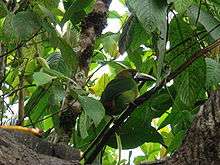
The emerald toucanet is a generally common in humid forest and woodland, mainly at higher elevations.
Behaviour and ecology
Small flocks, usually consisting of 5–10 birds, move through the forest in "follow-my-leader" style with a direct and rapid flight.
Breeding
The 3–4 white eggs are laid in an unlined hole in a tree, usually an old woodpecker nest, but sometimes a natural cavity. Both sexes incubate the eggs for 14–15 days, and the chicks remain in the nest after hatching. They are blind and naked at birth, and have short bills and specialised pads on their heels to protect them from the rough floor of the nest. They are fed by both parents and fledge after about 6 weeks. They are fed for several weeks after leaving the nest.
Food and feeding
This species is primarily an arboreal fruit-eater, but will also take insects, lizards,and eggs.
Relationship to humans
Aviculture

(nominate group)
The emerald toucanet is a popular pet toucan. It is affectionate when hand-fed and loves to play and interact with its owner. Emerald toucanets are as quick to learn tricks as cockatoos. They are active and need a large cage for their size, including perches that they can hop back and forth on. They also require a high-fruit diet, without which they are susceptible to a disease of excessive iron storage that is similar to hemochromatosis in humans.
References
- ↑ BirdLife International (2014). "Aulacorhynchus prasinus". IUCN Red List of Threatened Species. Version 2015.2. International Union for Conservation of Nature. Retrieved 26 August 2015.
- ↑ "Jacamars, puffbirds, toucans, barbets & honeyguides « IOC World Bird List". www.worldbirdnames.org. Retrieved 2016-11-02.
- ↑ "IOC World Bird List 6.4". IOC World Bird List Datasets. doi:10.14344/ioc.ml.6.4.
- ↑ "Jacamars, puffbirds, toucans, barbets & honeyguides « IOC World Bird List". www.worldbirdnames.org. Retrieved 2016-11-02.
- ↑ "Ramphastidae (Toucans, toucanets, & Aracaris)". www.nashvillezoo.org. Nashville Zoo.
- ↑ Short, Lester L.; Horne, Jennifer (2001). Toucans, Barbets & Honeyguides. Oxford University Press. ISBN 0-19-854666-1.
- Stiles, F. Gary; Skutch, Alexander F. (1989). A Guide to the Birds of Costa Rica. Comstock Publishing Associates. ISBN 0-8014-9600-4.
- Hilty, Steven L. (2003). Birds of Venezuela. Princeton University Press. ISBN 0-7136-6418-5.
External links
| Wikimedia Commons has media related to Aulacorhynchus prasinus. |
| Wikispecies has information related to: Aulacorhynchus prasinus |
- Bibliography of online, ornithological articles which explore the natural history of the Emerald toucanet, Aulacorhynchus prasinus prasinus
- Stamps (for Belize, El Salvador, Honduras, Mexico and Nicaragua) at bird-stamps.org
- "Emerald toucanet media". Internet Bird Collection.
- Emerald toucanet photo gallery at VIREO (Drexel University)
- Emerald toucanet species account at NeotropicalBirds (Cornell University)
